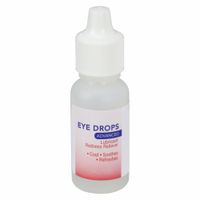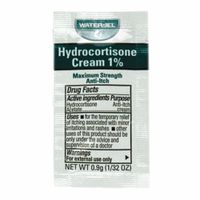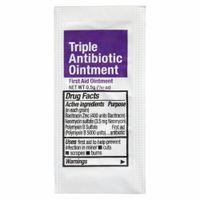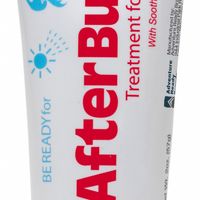Call +(254) 703 030 000 / 751 483 999 / 721 704 777
- Home
- Safety
- First Aid Wound Care
- Topical First Aid Medications Treatments
.....Read More
Frequently Asked Questions
What are the best topical antibiotics for treating cuts and scrapes?
The best topical antibiotics for treating cuts and scrapes include:
1. **Neomycin**: Often found in combination with other antibiotics, neomycin is effective against a broad range of bacteria. It is commonly included in over-the-counter ointments like Neosporin.
2. **Bacitracin**: This antibiotic is effective against gram-positive bacteria and is often used alone or in combination with other antibiotics. It is available in products like Bacitracin ointment and Polysporin.
3. **Polymyxin B**: Effective against gram-negative bacteria, polymyxin B is usually combined with other antibiotics like bacitracin and neomycin in products such as Neosporin and Polysporin.
4. **Mupirocin**: Available by prescription, mupirocin is effective against a wide range of bacteria, including methicillin-resistant Staphylococcus aureus (MRSA). It is often used for more serious or infected wounds.
5. **Fusidic Acid**: This prescription antibiotic is effective against gram-positive bacteria and is often used in countries outside the United States for treating skin infections.
6. **Silver Sulfadiazine**: Primarily used for burns, silver sulfadiazine has broad antibacterial properties and can be used for cuts and scrapes to prevent infection.
When using topical antibiotics, it is important to clean the wound thoroughly before application and follow the instructions on the product label or those provided by a healthcare professional. Overuse of antibiotics can lead to resistance, so they should be used judiciously. If a wound shows signs of infection, such as increased redness, swelling, or pus, or if it does not heal, seek medical advice.
How do topical antiseptics differ from topical antibiotics?
Topical antiseptics and topical antibiotics are both used to prevent and treat infections, but they differ in their mechanisms, scope, and applications.
Topical antiseptics are chemical agents applied to the skin or mucous membranes to reduce or eliminate microorganisms. They are broad-spectrum, targeting a wide range of pathogens, including bacteria, viruses, fungi, and protozoa. Common antiseptics include alcohol, iodine, hydrogen peroxide, and chlorhexidine. They work by disrupting cell membranes, denaturing proteins, or oxidizing cellular components, leading to the death of microorganisms. Antiseptics are used for wound cleaning, pre-surgical skin preparation, and hand sanitization.
Topical antibiotics, on the other hand, are medications specifically designed to target and kill or inhibit the growth of bacteria. They are more selective than antiseptics, focusing on specific bacterial strains. Common topical antibiotics include bacitracin, neomycin, and mupirocin. They work by interfering with bacterial cell wall synthesis, protein synthesis, or DNA replication. Topical antibiotics are used to treat localized bacterial infections, such as impetigo, minor cuts, and abrasions.
The key differences lie in their specificity and usage. Antiseptics are non-selective and can be used for general disinfection, while antibiotics are selective and used for treating specific bacterial infections. Overuse of topical antibiotics can lead to antibiotic resistance, a significant public health concern, whereas antiseptics are less likely to contribute to resistance due to their broad action. However, antiseptics can cause skin irritation or allergic reactions in some individuals.
In summary, while both are crucial in infection control, antiseptics are broad-spectrum agents for general disinfection, and antibiotics are targeted treatments for bacterial infections.
What is the most effective treatment for insect bites and stings?
The most effective treatment for insect bites and stings involves a combination of immediate first aid, symptom management, and, if necessary, medical intervention.
1. **Immediate First Aid**:
- **Remove the Stinger**: If stung by a bee, gently scrape the stinger out with a flat object like a credit card. Avoid using tweezers as squeezing can release more venom.
- **Clean the Area**: Wash the bite or sting site with soap and water to prevent infection.
- **Cold Compress**: Apply a cold pack or ice wrapped in a cloth to reduce swelling and numb the area.
2. **Symptom Management**:
- **Pain Relief**: Over-the-counter pain relievers like ibuprofen or acetaminophen can help alleviate pain.
- **Antihistamines**: Oral antihistamines such as diphenhydramine (Benadryl) can reduce itching and swelling.
- **Topical Treatments**: Hydrocortisone cream or calamine lotion can soothe itching and irritation. Baking soda paste or aloe vera gel may also provide relief.
- **Elevation**: If the bite or sting is on a limb, keep it elevated to minimize swelling.
3. **Medical Intervention**:
- **Severe Reactions**: Seek immediate medical attention if there are signs of an allergic reaction, such as difficulty breathing, swelling of the face or throat, dizziness, or a rapid heartbeat. An epinephrine auto-injector (EpiPen) may be necessary for those with known severe allergies.
- **Infection Signs**: If the area becomes increasingly red, warm, or pus-filled, consult a healthcare provider as antibiotics may be required.
4. **Prevention**:
- Wear protective clothing and use insect repellent when in areas with high insect activity to prevent bites and stings.
This comprehensive approach ensures effective management of insect bites and stings, minimizing discomfort and preventing complications.
How can I relieve pain and inflammation from minor burns?
To relieve pain and inflammation from minor burns, follow these steps:
1. **Cool the Burn**: Immediately run cool (not cold) water over the burn for 10-20 minutes. This helps reduce swelling and pain by dissipating heat.
2. **Clean the Area**: Gently clean the burn with mild soap and water to prevent infection.
3. **Apply a Cold Compress**: Use a clean, damp cloth as a cold compress to further reduce pain and swelling. Avoid using ice directly on the burn.
4. **Use Aloe Vera**: Apply pure aloe vera gel or a product containing aloe vera to soothe the skin and reduce inflammation. Aloe vera has natural anti-inflammatory properties.
5. **Apply an Antibiotic Ointment**: Use an over-the-counter antibiotic ointment to prevent infection and keep the area moist.
6. **Cover the Burn**: Protect the burn with a sterile, non-stick bandage or gauze. Change the dressing daily to keep the area clean.
7. **Take Pain Relievers**: Over-the-counter pain relievers like ibuprofen or acetaminophen can help manage pain and reduce inflammation.
8. **Avoid Breaking Blisters**: If blisters form, do not pop them, as this increases the risk of infection.
9. **Stay Hydrated**: Drink plenty of water to help your body heal.
10. **Avoid Sun Exposure**: Keep the burn out of direct sunlight to prevent further irritation.
11. **Monitor for Infection**: Watch for signs of infection, such as increased redness, swelling, or pus. Seek medical attention if these occur.
12. **Consult a Doctor**: If the burn covers a large area, is on the face, hands, feet, or genitals, or if you have concerns about healing, seek medical advice.
These steps can help alleviate pain and promote healing for minor burns.
What are the best topical skin protectants for preventing irritation?
The best topical skin protectants for preventing irritation include:
1. **Petrolatum (Petroleum Jelly):** A highly effective occlusive agent that forms a barrier on the skin, preventing moisture loss and protecting against irritants. It's ideal for sensitive skin and is often used in diaper rash creams and healing ointments.
2. **Zinc Oxide:** Commonly found in diaper rash creams and sunscreens, zinc oxide provides a protective barrier that soothes and protects irritated skin. It has anti-inflammatory properties and is effective in treating minor skin irritations.
3. **Dimethicone:** A silicone-based polymer that acts as a skin protectant by forming a barrier on the skin's surface. It helps to lock in moisture and is often used in lotions and creams for dry, irritated skin.
4. **Lanolin:** Derived from sheep's wool, lanolin is an emollient that helps to soften and protect the skin. It is particularly effective for dry, chapped skin and is commonly used in nipple creams for breastfeeding mothers.
5. **Colloidal Oatmeal:** Known for its soothing properties, colloidal oatmeal is used in creams and lotions to relieve itching and irritation. It forms a protective barrier on the skin and is beneficial for conditions like eczema and dermatitis.
6. **Aloe Vera:** A natural plant extract with soothing and anti-inflammatory properties. Aloe vera gel is often used to calm irritated skin and promote healing, making it a popular ingredient in after-sun products.
7. **Shea Butter:** A natural fat extracted from the nuts of the shea tree, shea butter is rich in vitamins and fatty acids. It provides a protective barrier and is excellent for moisturizing and soothing dry, irritated skin.
These protectants are widely available in various formulations, including creams, ointments, and lotions, and are suitable for different skin types and conditions.
How do I properly use first aid eye drops and eyewash solutions?
To properly use first aid eye drops and eyewash solutions, follow these steps:
1. **Wash Hands**: Begin by thoroughly washing your hands with soap and water to prevent introducing any contaminants into the eye.
2. **Check the Product**: Ensure the eye drops or eyewash solution is within its expiration date and has not been tampered with. Shake the bottle if the instructions indicate.
3. **Positioning**: Tilt your head back or lie down. If using eyewash, you may need to lean over a sink.
4. **Application**:
- **Eye Drops**: Pull down the lower eyelid to create a small pocket. Hold the dropper above the eye, without touching the eye or eyelid, and squeeze the prescribed number of drops into the pocket. Close your eye gently and press the inner corner to prevent the liquid from draining away too quickly.
- **Eyewash Solution**: If using an eyewash cup, fill it with the solution, place it over the eye, and tilt your head back, blinking to wash the eye. If using a bottle, squeeze the solution directly into the eye, ensuring it flows from the inner corner to the outer corner.
5. **Blink and Rest**: Blink several times to spread the solution evenly across the eye. Keep your eyes closed for a minute to allow the solution to work.
6. **Clean Up**: Wipe away any excess liquid with a clean tissue. Avoid rubbing the eyes.
7. **Storage**: Recap the bottle immediately and store it as directed, usually in a cool, dry place.
8. **Seek Medical Advice**: If irritation persists or if you experience severe discomfort, seek medical attention promptly.
Are there any side effects associated with using topical first aid medications?
Yes, there are potential side effects associated with using topical first aid medications. These medications, which include antibiotic ointments, antiseptic creams, and pain-relief gels, are generally safe when used as directed. However, some individuals may experience adverse reactions.
1. **Allergic Reactions**: Some people may be allergic to ingredients in topical medications, such as neomycin, bacitracin, or preservatives. Symptoms can include redness, itching, swelling, or a rash at the application site.
2. **Contact Dermatitis**: Prolonged use or sensitivity to certain ingredients can lead to contact dermatitis, characterized by skin irritation, redness, and itching.
3. **Delayed Healing**: Overuse of topical antibiotics can sometimes delay wound healing or lead to skin irritation, which may impede the natural healing process.
4. **Antibiotic Resistance**: Frequent use of topical antibiotics can contribute to antibiotic resistance, making infections harder to treat in the future.
5. **Systemic Absorption**: Although rare, some ingredients may be absorbed into the bloodstream, especially if applied over large areas or broken skin, potentially leading to systemic side effects.
6. **Photosensitivity**: Some topical medications can increase sensitivity to sunlight, leading to a higher risk of sunburn.
7. **Local Irritation**: Ingredients like alcohol or hydrogen peroxide in antiseptics can cause stinging or burning sensations upon application.
8. **Overuse Concerns**: Using more than the recommended amount can increase the risk of side effects without improving efficacy.
To minimize risks, it is important to follow the instructions on the label, use the medication only as needed, and consult a healthcare professional if you experience any adverse reactions or if the condition worsens.




